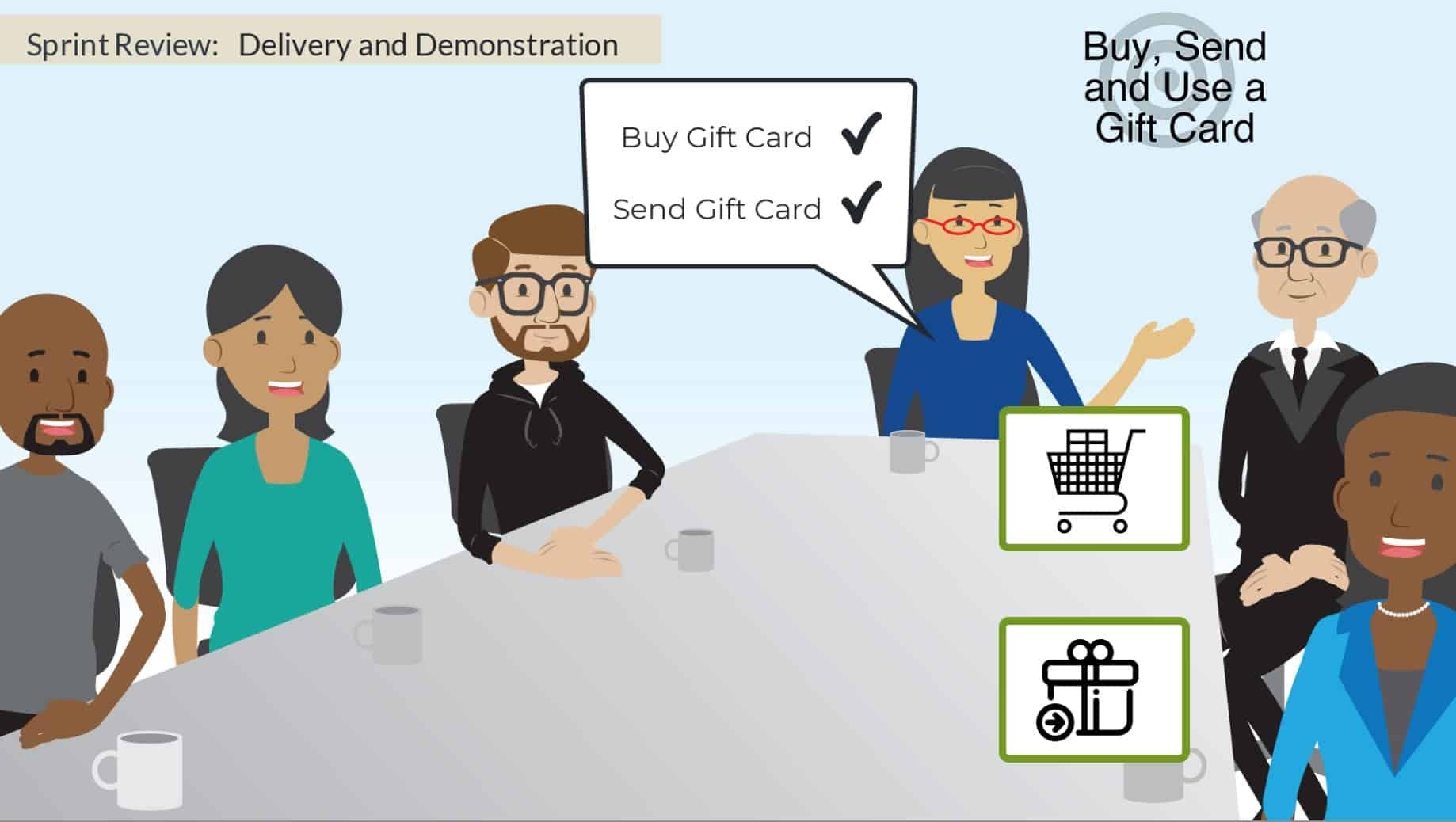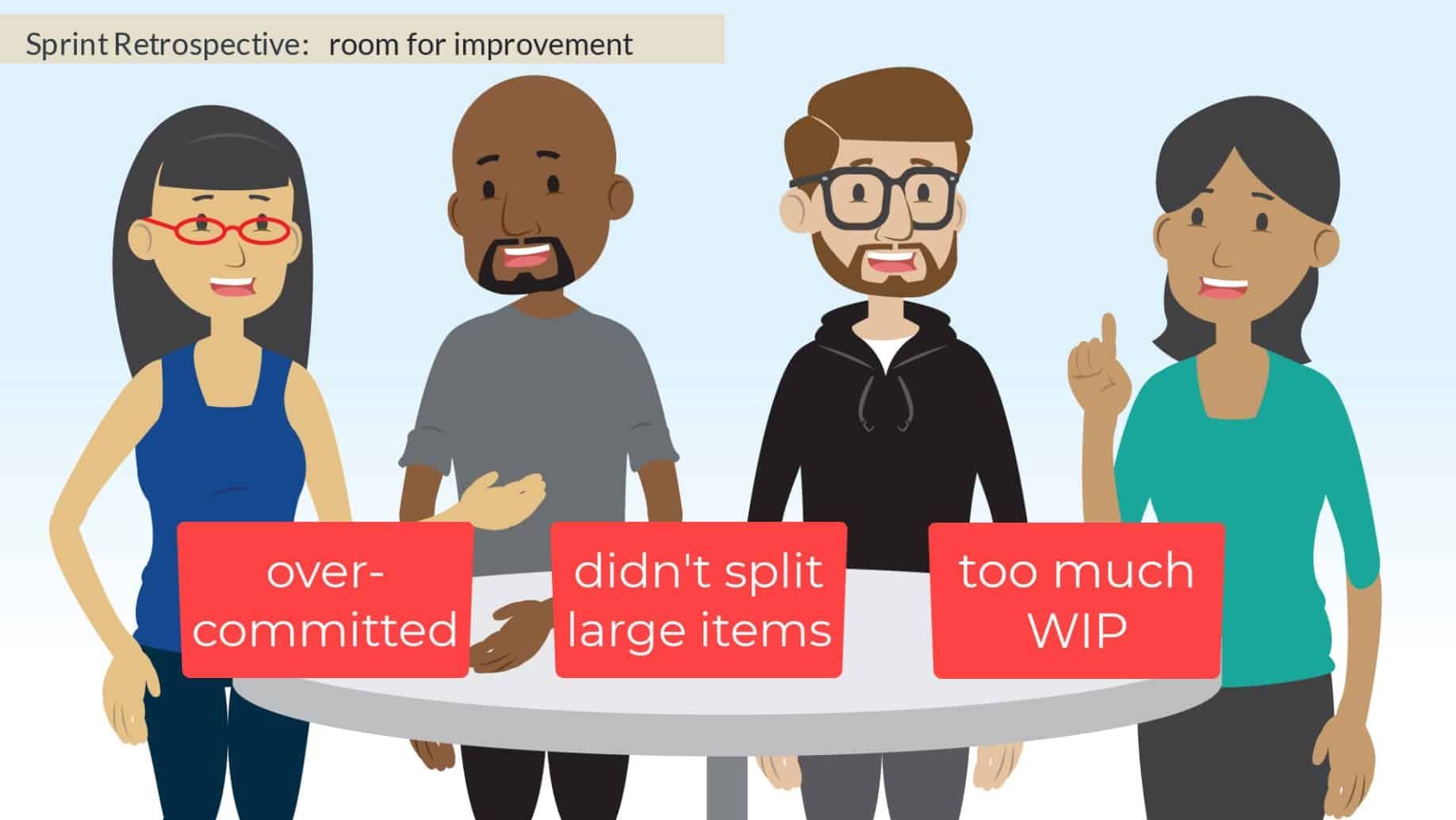- Home
- The Story of a Sprint
The Story of a Sprint
If the language of Scrum sounds intimidating to you, don't worry, you're not alone.
I get it, Scrum can be difficult to understand at first, but it’s a lot easier when you think about it as simply different steps that a team moves through as they build a working product, then continue to build and improve it.
To help show what I mean, let me introduce you to the WorldsSmallestOnlineBookStore.
The WorldsSmallestOnlineBookStore (WSOBS for short) is a fictional product we use to demonstrate how Scrum works in the real world. The bookstore caters to the view that Amazon is wrong. Readers don’t want an infinite supply of books that they have to spend hours agonizing over and deciding from. They just want the right choice for them, so they can quickly buy and then spend more time reading.
So we’re going to join the team who have already built and launched an early version of the bookstore website.
So far, the team has a website up and running where a book buyer can visit the site, find books recommended by staff, and purchase them. There is a rudimentary shopping cart system in place, but more features are needed.
We’ll use this scenario to demonstrate the different aspects of Scrum, in a way that moves the Scrum team through the process so you can understand how it’s structured, and – even more importantly – why.
Our Story So Far
The Scrum Team has just completed their ninth Sprint and they are about to meet with their ScrumMaster and Product Owner to begin the next one.
But before we let them jump into Sprint Planning, the first event in a Sprint, we need to clear up some common confusion. And to do that, we need to explain what Product Backlog Refinement is, and why it should happen before Sprint Planning ever begins.
Product Backlog Refinement – Before the Sprint Starts
The Product Backlog is the big picture list of all the items that the Team intends to build for a product or project in the near term.
Product Backlog Refinement is when the Product Owner and the Team refine that list to prepare for Sprint Planning, by ensuring that:
- the Team understand the work items in the Product Backlog so they build the correct thing (e.g. User Stories)
- the Team give their best guess as to how much effort Product Backlog item will take to complete (Estimation)
- and the Product Owner prioritizes the Product Backlog queue for what is next most important This Product Backlog Refinement is preparation work that happens before the first Sprint, and during, every subsequent Sprint.
Prioritization
That’s pretty self-explanatory, but let’s touch briefly on User Stories and Estimation.

User Stories
The team can’t build the right product unless they spend time with the Product Owner learning their current thinking. They do this by discussing each upcoming Product Backlog Item with the Product Owner to understand how it relates to a user’s needs.
This is where User Stories come in to use by many teams. In our WorldsSmallestOnlineBookStore example, Paula has collaborated with the team to create User Stories that describe each feature in a language that the whole team understands. Each User Story is a short description that acts as a reminder to the Team members of the bigger discussion they had around the user’s needs. They can be handy, but it’s important to note that User Stories are not officially part of, or required by, Scrum.
Estimation
Estimation is when the Team … well, estimates… how much work is required for each of those items on the list, and how long each will take to accomplish.
Story Splitting
The Team also split large Product Backlog Items into smaller, more manageable, parts during Product Backlog Refinement.
Many people think that Sprint Planning includes reviewing the Product Backlog Items (or User Stories) and Estimating them, but that just isn’t effective. Yet too many teams do this in Planning, and I strongly recommend against it. If you do it in a single session it takes forever and makes it difficult to also focus on planning. For a host of reasons, this leads to a crappy Sprint.
The Product Backlog Refinement preparation work should be ongoing and happen at any convenient time during the Sprint. This keeps the understanding about what they’re building current and consistent among all team members. That way, when Sprint Planning actually starts, the Team already has the best information to work with.
So now our World’s Smallest Online Bookstore Team has refined their Product Backlog and they can start their Sprint with a Sprint Planning session and focus on the question, “What is our Goal? Which Product Backlog Items can we do this Sprint that contribute towards our goal?”
Sprint Planning – Goal Setting
The Developers, along with ScrumMaster Steve and Product Owner Paula, meet at the beginning of their 10th Sprint for Sprint Planning. They start by discussing what they think they can accomplish in the next two weeks. This will become their Sprint Goal.
Paula explains that she has been getting a lot of requests for the ability to send gift cards to friends. She also wants to allow authors to give their readers discount codes, so that they can promote their new books.
The Team spends half an hour discussing the Backlog Items with Product Owner Paula to get more clarity, and they craft the following summary statement: “Buy, Send and Use Gift Card” as their Sprint Goal.
They decide that handling the discount code is too much work for the next two weeks and so they don’t do it this Sprint.
Sprint Planning – Sprint Backlog
After setting the Sprint goal, they walk through the product backlog, in priority order, determining which Product Backlog items they forecast they can achieve this Sprint.
Once the Team has determined what they’re capable of accomplishing in the Sprint, they finish planning by discussing how they are going to accomplish the work. Many teams also use this time to break their Product Backlog Items down into tasks. Since their discussion will be technical, Product Owner Paula steps out of the room to work on other things, but stays nearby in case the Team has follow-up questions.
After completing their Sprint Planning, the Team takes their list of Product Backlog Items with associated tasks and turn them into a Sprint Backlog (effectively a Task Board for the Sprint).
Sprint Begins
The Team selects two Product Backlog Items (PBIs) to start work on immediately. They break into groups: Tonia, Martin, and Doug tackle “Buy a $10 Gift Card”, and Brad, Ian, and Kirby work on “Send Gift Card by Email.”
For the next hour or two they work together to ensure that they have precise agreement about what they’re building and what the underlying need is. This will reduce the chance of a surprise after the Product Backlog Item is implemented when one Team member says that item isn’t built in the way they expected. For the next few days, they work on these PBIs.
To ensure everyone on the Team is collaborating and are focused on the goal, (“Buy, Send, and Use Gift Card”) they meet for Daily Scrum.
Daily Scrum
Daily Scrum is a short event that occurs first thing in the morning on each day of the Sprint. The Team stands in front of their Sprint Backlog to review where they’re at and recheck their progress towards the goal they set for the Sprint.
Each Team member explains:
- What did I complete towards achieving the Sprint goal in the past day?
- What do I commit to today towards achieving the Sprint goal?
- What is slowing our progress towards meeting the Sprint goal?
Since Daily Scrum is a self organizing activity for and by the team, they should adapt the questions to help them meet the need: improving collaboration and completion of the Sprint Goal.
Product Backlog Refinement… again…
Sometime during the Sprint the team work together for a couple of hours to refine the Product Backlog. This is the activity we discussed as happening before the Sprint began. The team work to see if all of the existing Product Backlog Items still make sense. They also split larger items as they move up the product backlog, and they estimate in preparation for the next Sprint Planning.
We do Product Backlog Refinement frequently to make sure that the Team always has a good understanding of what’s coming next in the Product, and to have the information needed for Sprint Planning at the start of each Sprint.
End of Sprint
As the Sprint draws to a close, our Team has had some successes and some challenges. Throughout the two-week Sprint, the Team collaborated to build and test the Product Backlog Items. In addition, they checked in with their Product Owner on a regular basis to ensure that they were delivering the product she expected. They have completed four of the five Items that they forecast they would achieve in Sprint Planning. They also checked them against the Definition of Done.
The Definition of Done is a checklist of specific criteria that the Team compiled to ensure that each item is, indeed, finished to a high standard of quality and is deliverable. It’s not a set-it-once and move on kind of thing. It gets updated frequently as the team learns more about their product and the technical environment, and as their skills grow.
Sprint Review
On the last day of the Sprint, the team gather with Paula (Product Owner), Steve (ScrumMaster) and various stakeholders to review what they have built. In the Sprint Review, Paula reminds people of the Sprint Goal, explains which Product Backlog Items, have been completed. She checks them against the Definition of Done list that the Team has previously compiled.

The “Done” items are shared so everyone has a good understanding of how the changes actually work. Ideally this isn’t done as a demonstration but, instead, with the stakeholders themselves using the done items. The intention is to engage them in the actual use of the product and ensure that their feedback is grounded in that personal experience. The group (including executives, end users and other interested people) collaborate on deciding what is the next most valuable thing to be worked on.
After a lot of discussion, it’s decided that the gift card features have been well enough implemented and that discount codes are no longer the highest priority.
The Team is now being asked to refocus on items that help to sell more books to the same customer.
The Product Owner wants bundle pricing – if you buy the book that you’re looking at along with two other books, you get a small discount. The hope is that this feature of the website will increase the volume of books being sold.
The resulting new Product Backlog Item is: “Related Products – Bundled Pricing” and it’s agreed that Paula will add this to the Backlog before the next Sprint. This is a great example of the power of Scrum and its ability to adapt quickly to the changing needs of a client.
Sprint Retrospective
Once the Sprint Review is complete, the Team, including Product Owner and Scrum Master, reconvene for a Sprint Retrospective to look at the last two weeks, with the goal of improving how they worked together in the last Sprint.
As a result of their discussion, the Team identifies several things that contributed to them missing the goal for the Sprint:
- They over-committed.
- They took on large Product Backlog Items without splitting them down to smaller Product Backlog Items.
- They put too much work into progress.

For the next Sprint they identified several improvements they could make:
Always split large Product Backlog Items into several smaller parts. Never have more than 3 Product Backlog Items in progress at once (this forces people to collaborate and focus on completing items). Find a way to start testing the original the Product Backlog Items before they’re complete Having completed their Sprint Retrospective, the Team is ready to start planning the next Sprint tomorrow morning.
Read more stories of the WorldsSmallestOnlineBookStore team finding their way with Scrum in Scrum by Example.
Your Guide to Everything Scrum
Mark Levison spent 12 years as a ScrumMaster and Coach, helping teams by chance before he started to systemize it. Armed with an insatiable love for research, he has been studying and teaching Agile since 2001, introducing Scrum, Lean, and Agile methodology to a broad range of individuals and organizations. Mark has helped launch Scrum practice throughout Canada including Government of Canada departments, major financial and insurance institutions, healthcare agencies, and leading payroll, HR services, and software companies.
Students and communities benefit from Mark’s more than thirty years of experience in the IT industry and over two decades of Scrum and Agile expertise, as he brings his uniquely fun and effective teaching style to thousands of individuals and teams so they can be more effective.
Frequently Asked Questions About Scrum and Scrum Events
Our story tries to answer many of the common questions about Scrum, but story-telling format can’t answer all questions. Below are some of the most common questions we hear.
Many assume that SCRUM is an acronym for something, but it’s not. You may have heard the term “scrum” before in reference to rugby, where it refers to a formation of players. A team that works together to move a ball toward a common goal. Don’t overthink it. The analogy works because of the simplicity of it in both contexts.
Serve their team. Not literally, like bringing coffee and running to the printer (although those are thoughtful too), but in the broad sense a Scrum Master is a servant-leader. They facilitate the various Scrum events and work with their team to identify obstacles, then help the team resolve them so they can perform efficiently while completing the project.
The Product Owner never lives the same day twice. Where the Certified Scrum Master focuses on taking a team beyond critical Scrum and Agile foundations and principles, and coaching them to build the best Scrum team, Certified Scrum Product Owners focus on working with teams to build and deliver the best products possible. Some days the CSPO spends most of the day working directly with customers, end users and other stakeholders understanding what the latest product needs are. Other days they spend their day with the Scrum Development Team sharing the knowledge of what they’ve recently learned from the customers. In terms of formal Scrum events, they’re responsible for Refining the Product Backlog. That includes deleting old items from the Product Backlog, reprioritizing, and finding new items. A couple of times every Sprint they meet with the rest of their team to conduct the Product Backlog Refinement event. In the event, a CSPO might summarize recent changes in priority (or old items deleted). A CSPO will also work with the team to understand new items, and answer questions in story splitting and estimation. And a CSPO might meet with team members to be shown the current version of features and provide feedback.
Get Certified
Explore what Scrum is and how to make it work for you in our Scrum Certification training. Hands-on learning will guide you to improve teamwork, deliver quick feedback, and achieve better products and results.
Registration is now open for workshops:
About this course
Focuses on the role of the team and the ScrumMaster. Get the skills and practical experience necessary to improve teamwork, take the exam, and advance your career with a certification that is in high demand today. Often the best fit for anyone new to Scrum.
Learning and Benefits
Relatable Scenarios
Learn on-the-job applications of key Scrum concepts, skills, principles, along with practical solutions that you can apply the next day for difficult, real-life situations.
Respected Certification
Everything you need to earn your Scrum Alliance® ScrumMaster certification, including exam fee and membership, and so much more.
Practical Exercises
With focus on the challenges that real teams face, and tools to dig deeper. You don’t need more boring Scrum theory. You need something you can sink your teeth into to see immediate results.
Jargon-Free Learning
This workshop is not just for software development or people with a computer science degree. We’ve helped many non-software teams with Scrum.
Career Advancement
Use Scrum knowledge to standout at work, get paid more, and impress your customer, all without burning out.
Ongoing Support
Our active Scrum community forum is a safe place to ask questions. Long after you earn the Certified Scrum Master certification, you will have access to the forum, course materials, and additional valuable resources.
